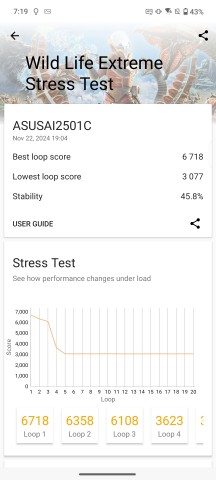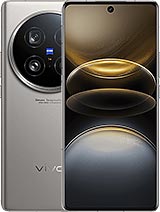Asus ROG Phone 9/9 Pro review

Synthetic benchmarks
Having the latest and greatest chipset around is already expected of ROG Phones as they aim to constantly be at the top of the mobile gaming scene. This year is no exception, with the ROG Phone 8 and 8 Pro both rocking the Qualcomm Snapdragon 8 Elite chip.
Since Asus' competitors have access to the same hardware, the company usually enhances the experience in other supplementary ways. Things like advanced cooling solutions, in-depth performance tuning, and user-accessible profiles and parameters to tweak. The ROG Phone 9/ 9 Pro is no exception.

The Snapdragon 8 Elite is a 3nm chip made on TSMC's N3E node. It is currently the cream of the crop of Qualcomm's lineup. In fact, it is such a powerful chip that it is also found inside laptops. The chipset has a two-plus six-core CPU configuration. All of the cores are Oryon cores. Two of them are prime cores, clocked at up to 4.3 GHz, while the other six are working at up to 3.53 GHz. These are basically the maximum clock speeds for the Snapdragon 8 Elite chipset.
Still, compared to last year's Snapdragon 8 Gen 3 chipset, the Snapdragon 8 Elite offers up to 45% increase in CPU performance, up to 40% GPU improvement and up to 40% NPU improvement. The new chipset also offers big efficiency optimizations. Asus tested some popular mobile games and discovered that the ROG Phone 9/9 Pro is up to 30% more efficient than the ROG Phone 8 generation.
The Snapdragon 8 Elite is paired with up to 24GB of LPDDR5X (9600Mbps this year, up from 8533Mbps last year) RAM and up to 1TB of fast UFS 4.0 storage. Our review unit for the ROG Phone 9 Pro happens to be the top-tier 24GB/1TB one, so the ROG Phone 9 Pro is definitely putting its best foot forward for our testing here. As for the regular ROG Phone 9, our review unit is the 16GB/512GB model.
Transitioning into some actual synthetic benchmarks, we ran all of our tests at the default Dynamic mode, X Mode, and X Mode+, which only gets unlocked and substitutes the regular X Mode when you attach the AeroActive Cooler X/ X Pro to the ROG Phone 9/9 Pro. We've left all the other in-depth tuning sliders on default, cooled the phone between runs and had the AeroActive Cooler X Pro manually set to max for those X Mode+ tests.

Let's kick things off with GeekBench and some CPU testing. The Snapdragon 8 Elite clearly stands above the competition. Not even Apple's A17 Pro can match the single-core performance of the new Snapdragon 8 Elite when X Mode is enabled. The Dimensity 9400 is no match either. Multi-core testing paints the same picture. The new Snapdragon 8 Elite is one beast of a chip.
AnTuTu is a much more compound benchmark with GPU and memory tests in the mix. It paints a similarly positive picture for the Snapdragon 8 Elite, but this time, MediaTek Dimensity 9400 and Snapdragon 8 Gen 3-powered phones are much closer on the ranking list. It is worth pointing out that the ROG Phone 9 generation uses very fast LPDDR5X RAM, and our ROG Phone 9 Pro review unit has a whopping 24GB of it on board.
The GPU benchmarks are of particular interest. You might notice that X Mode and X Mode+ consistently offer worse burst performance than the regular Dynamic profile on the ROG Phone 9th generation. This is by design, and it comes to show that Asus' performance optimization is a lot more complex than simply cranking up clock speeds as high as possible. On the contrary, in X Mode and X Mode+, GPU performance is moderated in order to be maintained for as long as possible and ensure a stable, prolonged gaming experience. In fact, Asus goes as far as to create specific CPU and GPU profiles for many popular games.
Perhaps it is also interesting to note that the Snapdragon 8 Elite and its Adreno 830 GPU do not technically top the GPU performance charts. The MediaTek Dimensity 9400 and its Immortalis-G925 GPU seem to have a small but measurable lead in the charts.
Thermal design and thermal throttling
Cooling a modern smartphone is challenging, especially with a flagship chipset. We like to call the ROG Phone technically not "passively cooled" due to the existence of the AeroActive Cooler, but that is just technically true. The phone itself is still a passive, sealed thermal system. In fact, the ROG Phone 9/9 Pro is more sealed than ever with its IP68 ingress protection rating.
That means that there is no longer an AeroActive portal like on the ROG Phone 7 generation, and with that, Asus also lost the ability to do convection cooling on the ROG Phone. So, to make up for the loss, Asus upgraded the internal conduction cooling setup to the best of its ability on the ROG Phone 9.
 Source: Asus
Source: Asus
Starting with the ROG Phone 6, Asus redesigned the phone's internals to have a central-positioned SoC, which, alongside the advanced cooling system, resulted in better thermals. This has been carried forward to the ROG Phone 7, the ROG Phone 8 and now the ROG Phone 9. As Asus calls it, the new "GameCool" system has an additional copper heatsink layer touching the central-mounted SoC and pulling heat away from it. The new heatsink is called a "Rapid Cooling Conductor," and it sits on top of the Boron Nitride layer, which is still in place in the ROG Phone 9/9 Pro. The graphite sheet layer volume has also been increased by a whopping 57%.
 Source: Asus
Source: Asus
The new Rapid Cooling Conductor is meant to pull heat away from the mainboard and dump it into the rear panel of the ROG Phone 9 where the AeroActive cooler is supposed to sit. And you can feel the system working in practice since that rear panel gets pretty toasty. The Rapid Cooling Conductor now has 20% improved cooling efficiency.
These upgrades to the thermal system have resulted in lower surface temperatures on the back cover of the device while gaming. The internal temperatures are more stable as well, with less fluctuation and hence more stable performance.
 Source: Asus
Source: Asus
Looking at our actual thermal-throttling test results, the ROG Phone 9 Pro does fairly well with prolonged stress and the entire passive cooling system seems to hold up for a good 10 minutes before it gets thermally saturated and gives way to thermal-throttling.
If you go for X-Mode without attaching the AeroActive cooler, the ROG Phone 8 Pro pushes itself harder at the beginning.
Finally, we did some testing with the AeroActive Cooler X Pro installed and working at full blast, with the fan and the active peltier cooler working as hard as possible. As expected, the ROG Phone 9 Pro holds its performance steady for a lot longer, with the AeroActive Cooler X Pro lending a hand.



CPU throttling test: Dynamic • X Mode • X Mode+ with cooler
We can only praise Asus' advanced cooling solution for the ROG Phone 9 Pro. That being said, if you want to make the most of it, you need to get the AeroActive Coole X Pro to ensure the best possible performance and hand comfort.



3D Mark throttling test: Dynamic • X Mode • X Mode+ with cooler
AeroActive Cooler X Pro
Asus' signature active cooling fan accessory for the ROG phone line has undergone so many design iterations that it probably deserves an article of its own. The AeroActive Cooler 6 saw what was arguably the biggest and most radical change to date with the introduction of an active peltier cooling element inside the gadget. That was carried forward to the AeroActive Cooler 7 and then the AeroActive Cooler 8, also known as the AeroActive Cooler X. Now, it is present in the AeroActive Cooler X Pro as well.

Last year, the AeroActive Cooler X saw some major downgrades, notably the removal of the built-in subwoofer. It also shed a lot of volume and weight and lost two buttons.
 Left: AeroActive Cooler X Pro • Right: AeroActive Cooler X
Left: AeroActive Cooler X Pro • Right: AeroActive Cooler X
The new AeroActive Cooler X Pro reintroduces the active subwoofer to the mix. This is why the X Pro model is a bit larger than the X. Other than that, the overall shape of the cooler accessory is the same. Asus decided not to bring back the two additional buttons, so you still get just two. These are omnidirectional and have very good tactile feedback.
The AeroActive Cooler X Pro has a male USB-C connector that plugs into the phone and a female USB-C port, which can pass through all of the features you'd normally use the phone's port for - charging, HDMI out, etc.
The Type-C port will typically be taken up by a charger. In fact, to use the cooler at its maximum cooling capacity (Frozen mode, with the fand and peltier at full blast), you must have the charger connected.

After skipping the 3.5mm audio jack on the AeroActive Cooler 6, Asus returned it on the AeroActive Cooler 7, and now it is still present.
The attachment of the AeroActive Cooler X Pro is achieved via a spring-loaded latch mechanism that has a button to release and a ratchet mechanism to close back up. The fit is very snug, and putting the cooler on and taking it off is relatively easy as long as you properly line up the Type-C port.
In case you were wondering what happens to the power button once the AeroActive Cooler X goes on, Asus thought of that and has added a piece of flexible rubber to "extend" the button outward, making it still usable. Pressing is a bit awkward, but it does the job alright.

The two programmable physical buttons feel great, and with them being omnidirectional, you can press them in any spot you want and in any "direction," so to speak.

The AeroActive Cooler X Pro has its own RGB lighting, which illuminates and shines through the middle transparent plastic bit and the small ROG logo. Once the accessory is on, a lighting menu will appear.
By the way, while this transparent plastic bit looks great while illuminated, we really don't like the plastic itself. It scratches really easily and just looks ugly once that inevitably happens. But that's us nitpicking.
The last functional bit is an extendable kickstand. It comes up from the bottom of the AeroActive Cooler and generally does a great job supporting the phone. Its angle is not adjustable or anything fancy like that. You just get one setting.

On to functionality, then. The basic principle of operation for the AeroActive Cooler X is easy to understand - the cooler sits on the back of the phone, covering its "hot spot" in the middle, where the centrally-mounted PCB resides. There is a thermally conductive pad on the outside part, a copper plate, some radiators, and a fan inside.
The "special sauce", just like last year, is the peltier element, sometimes called a TEC. It is a thermoelectric piece that takes current and then uses that to make one of its sides cold and the other hot. So what is happening is that the AeroActive Cooler X Pro is actively cooling down the back of the phone while the radiator and fan are actively cooling off and pulling heat off the TEC's hot side.


AeroActive Cooler X Pro settings
The AeroActive Cooler X Pro actually has its own settings menu within Armoury Crate, which, among other things, lets the user choose between four modes of operation. Smart is a sort of auto that monitors thermals and decides how much to power the fan and the peltier. Cool mode just uses the fan to dissipate heat without turning on the peltier. Frosty and Frozen modes have both the fan and the peltier working. Frosty has the peltier working with a lower current. Basically, as much as the phone can provide via its Side port. The AeroActive Cooler X Pro needs external power hooked up in its top Frozen mode.

On the subject of noise, the AeroActive Cooler X Pro is not particularly quiet. It is very much audible in any setting and can get particularly distracting in Frozen mode. Despite its big size, its fan is still relatively small, and there is simply no way around generating at least some noise. At least the fan noise can be easily drowned out by the Rog Phone 9/ 9 Pro speakers. Still, don't expect anything akin to a stealthy and quiet gaming experience with the AeroActive Cooler X Pro attached.
Closing off the AeroActive Cooler X Pro section, we should mention that it has a 12.5% larger fan diameter and extended thermal material. Colling efficiency on the AeroActive Cooler X Pro has apparently been improved by 29% overall compared to the AeroActive Cooler X.
Reader comments
- Denshaotoko
- 13 Feb 2025
- 15S
Got non pro version pre-order discount for 899 off Asus official store. Only lacking less animex pixels and replace with one macro camera. No bad product only bad price. very good deal.
- Gto
- 22 Jan 2025
- Q{d
My biggest gripe with ROG phones was the design, because otherwise they had pretty much everything I wanted: fast USB, headphone jack, flat screen, powerful cpu, battery management and such. So last year I gave the ROG 8 pro a try, the lack of l...
- Architect
- 20 Jan 2025
- d%C
Hahaha how is the oneplus 13 better option even for games; 😂 rogphone 9 pro is the strongest phone in raw power, even without x mode or even the aerocooler still outperformed everything out there. One plus 13 is a good daily phone for 800 bucks and t...















